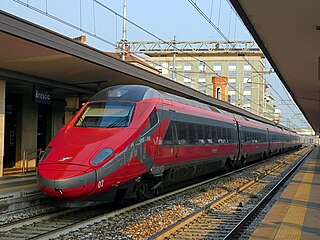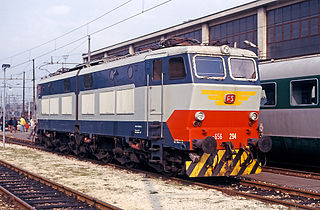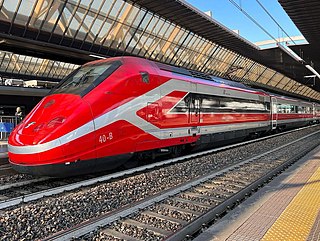
A tilting train is a train that has a mechanism enabling increased speed on regular rail tracks. As a train rounds a curve at speed, objects inside the train experience centrifugal force. This can cause packages to slide about or seated passengers to feel squashed by the outboard armrest, and standing passengers to lose their balance, or in such excessive speeds, could even cause the train to derail. Tilting trains are designed to counteract this by tilting the carriages towards the inside of the curve, thus compensating for the g-force. The train may be constructed such that inertial forces cause the tilting, or it may have a computer-controlled powered mechanism.

Pendolino is an Italian family of high-speed tilting trains used in Italy, Spain, Germany, Poland, Portugal, Slovenia, Finland, the Czech Republic, Slovakia, the UK, the US, Switzerland, China, and Greece. It was also used in Russia from December 12, 2010 until March 26, 2022. Based on the design of the Italian ETR 401, it was further developed and manufactured by Fiat Ferroviaria, which was taken over by Alstom in 2000.
Trenitalia SpA is the primary train operator of Italy. A subsidiary of Ferrovie dello Stato Italiane, itself partly owned by the Italian government, the company is owned publicly and partly private from a private investors group. It was established in 2000 following a European Union directive on the deregulation of rail transport.

Ferrovie dello Stato Italiane S.p.A. is Italy's national state-owned railway holding company that manages transport, infrastructure, real estate services and other services in Italy and other European countries.

The Baureihe 103 is a class of electric locomotives in Germany, originally operated by Deutsche Bundesbahn. For a long period, they were perceived as flagships of the DB rolling stock.

ETR 450 was the first series Italian tilting train.

The FS E.645 and E.646 are two classes of similar electric locomotives used on Italian railways. They were introduced during the 1950s and they were retired in 2009.

The FS E.636 is a class of Italian articulated electric locomotives. They were introduced in the course of the 1940s until the 1960s, and have been decommissioned since 2006. They have been one of the most numerous Italian locomotive groups, and have been widely employed during their long career, hauling every type of train, ranging from freight to long range passenger services. Their introduction also saw the employment of some revolutionary design concepts, such as the articulated carbody and the three bogies scheme.

The Italian railway system is one of the most important parts of the infrastructure of Italy, with a total length of 24,227 km (15,054 mi) as of 2011.

The Class E.656 is an Italian articulated rheostatic-type electric locomotive built from 1975 to 1989. An evolution of the E.646, they are mixed traffic locomotives, and have been used on every kind of train, ranging from freight to intercity passenger transport.

The ETR 200 is an Italian electric multiple unit (EMU) introduced in 1936.

The FS E.632 and E.633 are two classes of Italian railways electric locomotives. They were introduced in the course of the 1980s.

The FS E.424 is a class of Italian railways electric locomotives. They were built in 1943-1951 and have been decommissioned in 2008.

E.402A/B is a class of electric locomotives mainly used on medium speed passenger trains by the Italian railway company FS Trenitalia.

The ETR 300, also known as "Settebello-type" for its use on the former Settebello train service, is a type of Italian fast electric multiple unit (EMU) trainset formerly operated by Ferrovie dello Stato. The letters ETR stood for elettrotreno rapido. Thanks to its aerodynamically low-drag profile, it boasted a maximum speed of 200 km/h (124 mph), with a power output of 2600 kW. Manufactured for FS by Breda, a total of only three trainsets were built, numbered ETR 301–303.

The FS E.326 was a class of Italian railways electric locomotives. Designed in 1929, they were introduced in the early 1930s, for hauling light express passenger trains at high speeds.

ETR 500 is a family of Italian high-speed trains built by AnsaldoBreda and introduced in 1993.

The Frecciarossa 1000 is a high-speed train operated by Italian state railway operator Trenitalia and the private Spanish high-speed rail operator Iryo. It was co-developed as a joint venture between Italian rail manufacturer Hitachi Rail Italy and multinational conglomerate Alstom. Both design and production work were divided between the two partner companies.
Frecciabianca is a high-speed train operated by Trenitalia, Italy's national train operator, and one of its Le Frecce brands, along with Frecciarossa and Frecciargento. Frecciabianca was introduced in 2011, replacing Eurostar Italia. Frecciabianca trains operate at speeds up to 200 km/h (124 mph).
Le Frecce is the high-speed rail train category operated by Trenitalia in Italy under overall three brand names.


















